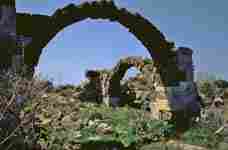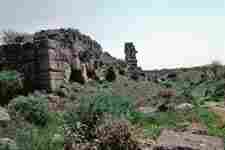.

Alexandria Troas ("Alexandria of the Troad", mod. Eski Stambul) is an ancient Greek city of the Troad, situated on the Aegean coast at nearly its middle point, a little south of Tenedos (modern Bozcaada). It is located in the modern Turkish province of Çanakkale.
According to the Catholic Encyclopedia, this site was first called Sigia; perhaps about 310 BC Antigonus refounded the city as Antigonia Troas. Early in the next century the name was changed by Lysimachus to Alexandria Troas, in memory of Alexander the Great (Pliny, N.H. 5.124 merely states that the name changed from Antigonia to Alexandria). As the chief port of north-west Asia Minor, the place prospered greatly in Roman times, and the existing remains sufficiently attest its former importance. Strabo mentions that a Roman colony was created at the location in the reign of Augustus, named Colonia Alexandria Augusta Troas (called simply Troas during this period). Augustus, Hadrian and the rich grammarian Herodes Atticus contributed greatly to its embellishment; the aqueduct still preserved is due to the latter. Constantine I considered making Troas the capital of the Roman Empire.
In Roman times, it was a significant port for travelling between Anatolia and Europe. Paul of Tarsus sailed for Europe for the first time from Alexandria (Acts, 16:8-11), and returned there from Europe (and there occurred later the episode of the raising of Eutychus (Acts 20:5-12). Ignatius of Antioch also paused at this city before continuing to Rome (Ad Philad. 11.2; Ad Smyrn. 12.1).
Several of its later bishops are known: Marinus in 325; Niconius in 344; Sylvanus at the beginning of the fifth century; Pionius in 451; Leo in 787; Peter, friend of the Patriarch Ignatius, and adversary to Michael, in the ninth century. In the tenth century Troas is given as a suffragan of Cyzicus and distinct from the famous Troy (Gelzer, Ungedruckte . . .Texte der Notitiae episcopatuum, 552; Georgii Cyprii descriptio orbis romani, 64); it is not known when the city was destroyed and the diocese disappeared.
The site as of 1911 was covered with vallonea oaks, and has been much plundered (for example Mehmed IV took columns to adorn his new Valideh mosque in Istanbul), but the circuit of the old walls can be traced, and in several places they are fairly well preserved. They had a circumference of about six English miles, and were fortified with towers at regular intervals. Remains of some ancient buildings, including a bath and gymnasium, can be found within this area. Trajan built an aqueduct which can still be traced. The harbour had two large basins, now almost choked with sand.
This article incorporates text from the 1911 Encyclopædia Britannica, which is in the public domain.
This article incorporates text from the Catholic Encyclopedia, which is in the public domain.



| Ancient Greece
Science, Technology , Medicine , Warfare, , Biographies , Life , Cities/Places/Maps , Arts , Literature , Philosophy ,Olympics, Mythology , History , Images Medieval Greece / Byzantine Empire Science, Technology, Arts, , Warfare , Literature, Biographies, Icons, History Modern Greece Cities, Islands, Regions, Fauna/Flora ,Biographies , History , Warfare, Science/Technology, Literature, Music , Arts , Film/Actors , Sport , Fashion --- |
Retrieved from "http://en.wikipedia.org/"
All text is available under the terms of the GNU Free Documentation License


